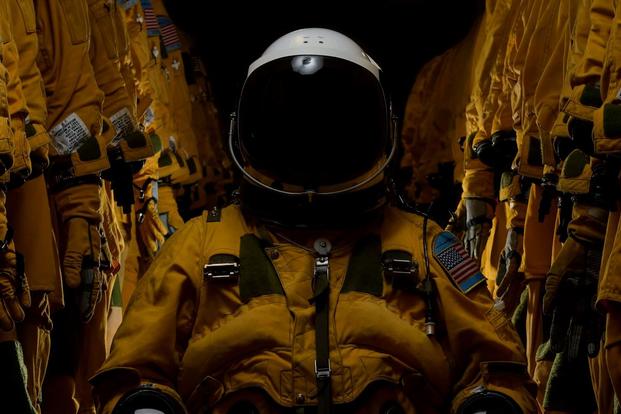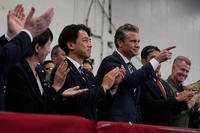It was about 10 years ago when Brent Beck took off from Beale Air Force Base, California, on one of his first night training flights in the U-2 Dragon Lady high-altitude spycraft.
Suddenly, cabin pressure in the U-2, which is capable of flying at 70,000-plus feet, began to drop. Beck deduced the problem was due to a faulty canopy seal, but says he wasn't worried because his fully pressurized space suit kicked in just as designed.
"It's one of those things where the people that work on the suit treat it just like it's an airplane -- it has its own inspection records; [technicians] take meticulous care of it. And [because of] their efforts, that suit protected me. I mean, it honestly saved my life," said Beck, who is now the chief U-2 test pilot for Lockheed Martin.
The aircraft's decades-long mission is to gather intelligence, and its capabilities take pilots to the brink of space. But it would be impossible without pressurized space suits.
As the custom-made, smart-tech flight suits continue to improve, there’s no shortage of cutting-edge ideas to keep U-2 pilots soaring, and engineers are using emerging technologies to add mobility and develop even sleeker pressurized suits for the next batch of NASA astronauts who are getting ready to head out into the final frontier.
Related: U-2 Pilot Dismissed for Shaving His Entire Body to Avoid a Drug Test
"Folks want to wear something extremely comfortable, lightweight," said Shane Jacobs, the Softgoods Design Manager at David Clark Company. For decades, the company has provided military and commercial suits to help regulate oxygen and blood pressure at extremely high altitudes.
"The company has embraced new technologies for both design and manufacturing," Jacobs said in a recent interview. "Molds that years ago would have been sculpted by hand by highly skilled craftsmen are now designed by talented engineers using 3D [computer-aided design] tools, and produced with additive manufacturing techniques.
"Likewise, laser body scans and 3D anthropometric modeling tools now augment traditional pattern design and grading, which was once done entirely by hand," he added.
The key is to keep pilots safe and comfortable no matter how the suits are crafted, said David Knapp, the U-2 Life Support Program's program manager.
"The main thing is making sure that they're confident every time they go up, but if there was something that did go wrong, that suit's going to protect them."
Looking to NASA
The U-2 and space programs can benefit one another, Knapp said.
"Whatever they're looking into [for] other suits, where we could benefit from too is movability … give more flexibility," he said. "If NASA is working on something with a suit … that we can both benefit from, we can save a lot of money [instead of] duplicating efforts in research and development."
Air Force officials and pilots recently received a demonstration on the suit the company is developing for the planned Artemis missions to the moon, known as the Orion Crew Survival System (OCSS), according to Knapp.
While he could not discuss the U-2 and Orion space suit comparisons directly, he said it gives the Air Force a glimpse into the future of pressurized suit technology.
The OCSS, for example, has been designed with enhanced range of motion and thermal regulation to keep astronauts ambulatory while safeguarding body temperature.
While U-2 pilots typically fly for 10 to 12 hours at a time, NASA is requiring the OCSS to be capable of supporting astronauts for up to six days should the Orion capsule lose cabin pressure.
"It's just 'gee-whiz' stuff that this kind of stuff is possible," Knapp said.
Under Pressure
The David Clark Company in Worcester, Massachusetts, has been the sole provider of Dragon Lady uniforms almost since the aircraft entered service in the early 1960s.
Founded in 1935, the company amassed 500 employees to make form-fitting undergarments such as bras and girdles.
"They were the kind of 'Spanx' of the day," Jacobs said.
Founder David Clark focused more on function, not fashion. When World War II erupted, Clark already had the know-how when it came to compression garments -- something that became essential for pilots with the use of G-suits.
Other innovators included Wiley Post, who brought his idea for a pressure suit to Wright Field in Ohio, which eventually became Wright-Patterson Air Force Base. The base now houses the Air Force Research Lab, among other crucial aeromedical testing units.
"He had an eyepatch [and] was something of a rebel in the field," said Kevin Rusnak, historian for the Air Force Research Lab in Dayton, Ohio. "But he had this idea, 'OK, well I'm going to build a pressure suit so I can fly higher than everybody, get up in the jet stream and go faster and farther so I can win air races."
Post, who in 1933 accomplished the first solo flight around the world in seven days and 18 hours, worked with Russell Colley, the lead mechanical engineer of the B.F. Goodrich Company -- a rubber manufacturing business -- to craft the first-ever pressure suit.
Despite its flaws, and redesign efforts, Post got it to work for a few flights in 1934, Rusnak said. But he "was never actually able to race successfully with it."
Post died a year later when his aircraft crashed during takeoff in Alaska. Still, through his research and testing, "he basically demonstrates that a pressure suit in principle can work," Rusnak said.
Meanwhile, Clark wanted to experiment with inflatable bladders, but couldn't because the company lacked the techniques to make them.
"He just had knitting facilities," Jacobs said. "As legend goes, he went to the local store, bought a football, took the bladder out of the football and rigged up the very first prototype."
Clark came up with an idea for a valve that would sense the G-forces that the plane was under and either inflate or deflate the football depending on the force applied. The football-turned-prospective bladder would fill up with enough air to squeeze pilots' blood into higher parts of their bodies to help them stay conscious.
Other companies such as International Latex Corporation, now ILC Dover, also got in the game.
But working with the Mayo Clinic, David Clark found enough success to create the G-suit technology, partial pressure suits and, eventually, the full-pressure suits used today.
"We've made so many different suits for so many different systems, it would take a research project to try to get exact quantities," Jacobs said.
The company has moved away from G-suit production to manufacture only full-pressure suits.
"Absent exact numbers, you could state that we've designed, developed and manufactured aerospace crew protective equipment for nearly every crewed high-altitude and space program to date," Jacobs said.
Custom-fit, Added Improvements
A David Clark suit is customized for each vehicle and each mission, stitched and sealed by hand and integrated with hardware that will tightly hug the body in the event of a dramatic pressure change.
The U-2 helmet shell and visor are crafted together with the company's special mold, Jacobs said, and have become lighter over time.
Each piece is inspected, tested and retested just like an aircraft undergoing maintenance. The suit has built-in capabilities to allow the pilot to eat through a feeding tube, as well as go to the bathroom.
One recent change is a protective U-2 coverlet in the same eye-catching golden color as the suit, Knapp said. "We've incorporated as an outer one-piece cover, which just basically moves all the pockets and everything ... to the outer cover. We've already had them tested and approved, [and] they are in use."
The coverlet helps decrease maintenance and cleaning.
"With the suit, it's really easy to pull that cover off and ... they can actually machine wash them and clean them, and then they can put it back on the suit," Knapp said.
Over the last 30 years, radical improvements have come just from new materials.
"As suit developers and suit designers, our competition hasn't necessarily been other suit companies," Jacobs said. "Our competition has been plain clothes."
Gore-Tex, for example, replaced the suit's inner bladder for moisture wicking and breathability, which in turn regulates body temperature more effectively.
"Instead of being inside a dishwashing glove ... it's a selectively permeable material that lets water vapor transmit while still being impermeable," Jacobs said.
If avionics inside the U-2 become smaller and more modernized, it may require other upgrades to the suit.
"A lot of things are touchscreen now," said Beck, who's flown the U-2 for nearly 10 years between his active-duty service and as Lockheed's test pilot.
"As we progress in technology, that may be one of those things we're going to need to have in the airplane," he said.
David Clark is already working on touch-screen gloves for the Orion program, as well as Boeing Co.'s CST-100 Starliner capsule to ferry astronauts to and from the International Space Station (ISS), Jacobs said.
Upgrades may also include enhanced helmets.
"There's a range of things" being discussed, Knapp said. "Like active noise reduction or like an extra light or something in the helmet," similar to that of fighter pilots.
"We're throwing [these ideas] around a little bit," he said.
Adapting to the Human
Over the years, researchers have improved ergonomic design, life support equipment and cockpit instruments and automation by factoring in the human point-of-view, said Tim Schultz, associate dean of academics at the U.S. Naval War College.
"In many cases, the machine is a superior means of control. Not in every case, but in many cases," said Schultz, who authored "The Problem with Pilots: How Physicians, Engineers, and Airpower Enthusiasts Redefined Flight."
"It's really the human is who's holding us back; the human is the weakest link in the system," he said.
The Air Force changed the U-2's cockpit cabin pressure regulator after pilots in the mid-2000s raised concerns over spikes in decompression sickness, or DCS, they experienced during longer flights. DCS is caused by nitrogen bubbles forming in the blood or muscle, leading to pain, nausea, fatigue and other severe conditions.
Materials are the most likely factor to evolve, Schultz said.
"There certainly could be some type of better fabric or textile or something ... that will be more form fitting, and maybe doesn't have to inflate so much in order to exert pressure around every square inch of the entire body," Schultz said.
While there are no formal requirements to drastically upgrade the U-2 suit, some ideas are being kicked around.
Developers could create a suit that would be "less maintenance intensive on the field technicians to where, maybe it costs just a little more for the suit, but it's saving hundreds of hours and field repairs or inspections," Knapp said.
"If you just look at your iPhone that you had five years ago, it's nothing compared to what you have now," Beck said.
"There's this inherent variation that has to be accounted for in how we integrate humans and machines," Schultz added. "The pressure suit is one way to overcome those variations, but it also has to accommodate for those variable humans, too."
-- Oriana Pawlyk can be reached at oriana.pawlyk@military.com. Follow her on Twitter at @Oriana0214.
Read more: Pentagon Leaders Tell Troops to Stop Using Mail-In Genealogy DNA Kits














